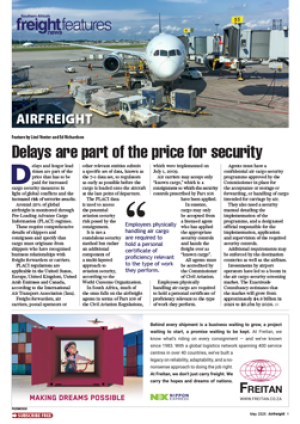Walvis Bay has a new skyline – the port city is dominated by four post Panamax ship-to-shore (STS) gantry cranes that arrived in February this year.
Their shadows stretch for thousands of kilometres – they are a constant reminder that Namibia is putting its money where its mouth is when it comes to realising the ambition of being the preferred trade gateway for neighbouring Southern African Development Community (SADC) countries.
The cranes have arrived and have been installed well ahead of schedule – the new container terminal is scheduled to commence commercial operations in mid-2019.
It will have two 600-metre-long berths and have the draught to accommodate container vessels of 8 000 TEUs, bringing the capacity of the port to 750 000 TEUs a year – more than double the current 350 000 TEUs.
Efficiencies will also increase. Speaking at the ceremony which marked the arrival of the US$9- million-a-piece STS gantries, Namibian Ports Authority (Namport) chief executive officer Bisey Uirab said the productivity per crane hour would go from 15 on the present rubber-tyred gantries to 40.
“The ship-to-shore crane is the largest container-handling equipment and will improve efficiencies and enable faster ship turnaround time, which will make our terminal attractive for shipping lines,” he said. But the government recognises that the port needs landward as well as seaward connections in order to be a true gateway.
The pressure is now on the agencies tasked with upgrading the support infrastructure and links to the port. Namibian president Hage Geingob referred to the shoreside infrastructure in his 2018 state of the nation address.
He said the servicing of the 34- hectare Ha!Nara Namib Industrial Park outside Walvis Bay would be completed during the current financial year. “Eventually, this site will reach 400 hectares and will be turned into an industrial park for local and international companies,” he said.
The industrial park stretches from the outskirts of Walvis Bay towards the international airport. Namibia also wants to control its meat exports – a trend that will probably continue with other exports. “Four hectares of land have been made available for the construction of a beef cold storage facility within the Ha!Nara Namib Industrial Park.
“The establishment of this facility is a vital cog in our quest to develop our meat export capacity, as it will enable Namibia to export beef via Walvis Bay instead of through neighbouring ports,” he said.
At the other end of the Walvis Bay–Windhoek run is the Brakwater industrial estate 20 kilometres outside Windhoek on the B1 route between the two centres. The B1 between Windhoek and Okahandja is in the process of being upgraded to a four-lane highway.
There are also plans in the pipeline to establish dry ports at strategic junctions such as Grootfontein, Windhoek and Oshakati to reduce logistics costs by combining rail and road.
The plan is for loads to be trucked from the Copperbelt to Grootfontein, where they will be transferred onto rail for the remainder of the journey to Walvis Bay – and vice-versa. That is until the rail link between Grootfontein and Katima Mulilo through to the Copperbelt becomes a reality.
Namibia has a plan – the Master Plan for Development of an International Logistics Hub for SADC Countries in the Republic of Namibia – and the STS cranes, roadworks and new logistics facilities show that the government has the will to make the necessary investments.
Having a cost-efficient western gateway will be a game-changer for Namibia’s land-linked neighbours – and for South Africa as Walvis Bay becomes real competition for Durban.
CAPTION
New gantries with admin buildings taking shape in the background.

